Oh boy. Saint Petersburg is a little different, a very noticeable diversion from the Russian city norm. Whereas the rest of them, in comparison, are full of dull, grey unimaginative structures (run-of-the-mill Soviet architecture), Saint Petersburg is a fairy tale city of incredible weathered architecture complete with canals, baroque palaces, cathedrals and buildings made from pink granite with yellow & green facades. The city was founded in 1703 by Peter the Great, the then ruling Tsar, & built on a mosquito-infested swamp at the mouth of the Neva River on the shores of the Gulf of Finland. Peter hated Moscow, then the capital, and he had a vision to create a modern capital for a country that he deemed to be stuck in the Dark Ages. Military scuffles with Sweden meant Peter had thousands of Swedish prisoners of war at his disposal and he soon succeeded in creating his dream. In 1713 Saint Petersburg became the nation’s capital and it remained the heart of the country until the 1917 revolution ended the Russian dynasty – a year later, in 1918, the victorious communists moving the capital back to the more easily defensible Moscow. For the next 80 or so years the city was more or less ignored by Moscow and many of its fabulous buildings fell into disrepair. But with local boy Vladimir Putin now pulling the shots in Moscow the city, and its crumbling palaces, have profited from central funding. As a result today Saint Petersburg, Europe’s 4th largest city, is one of the most enchanting and impressive cities on earth.
– Robert Kaiser, Russia: The People and the power (1984)
Nevsky Prospekt
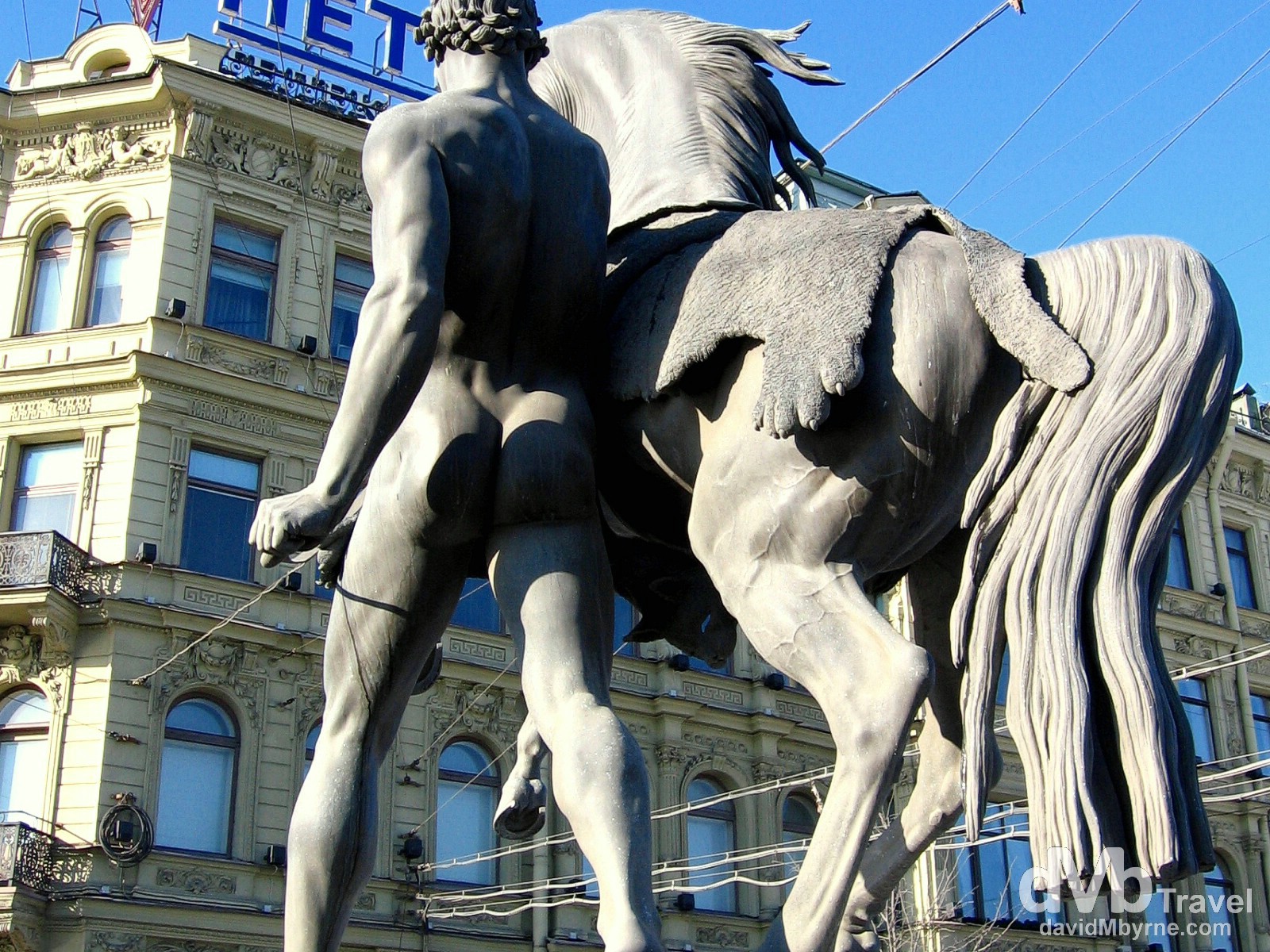
A picture showing one of the four bronze, neoclassical sculptures found on each corner of the Anichkov Bridge on Nevsky Prospekt. The Anichkov Bridge was the first bridge to cross the city’s Fontanka River and was first built in 1715 by order of Peter the Great. It is named after its engineer, Mikhail Anichkov. The sculptures, entitled The Horse Tamers, are of naked men taming horses and the story goes that the sculptor was a bit overly generous to one of the horses, meaning one of them is… well, you get the idea. In the background you can see some of the distinctive yellow buildings of Nevsky Prospekt, the city’s main thoroughfare, buildings that give this city its unique feel. Nevsky Prospekt, Saint Petersburg (![]() ), Russia. February 27, 2006.
), Russia. February 27, 2006.
Kazan Cathedral
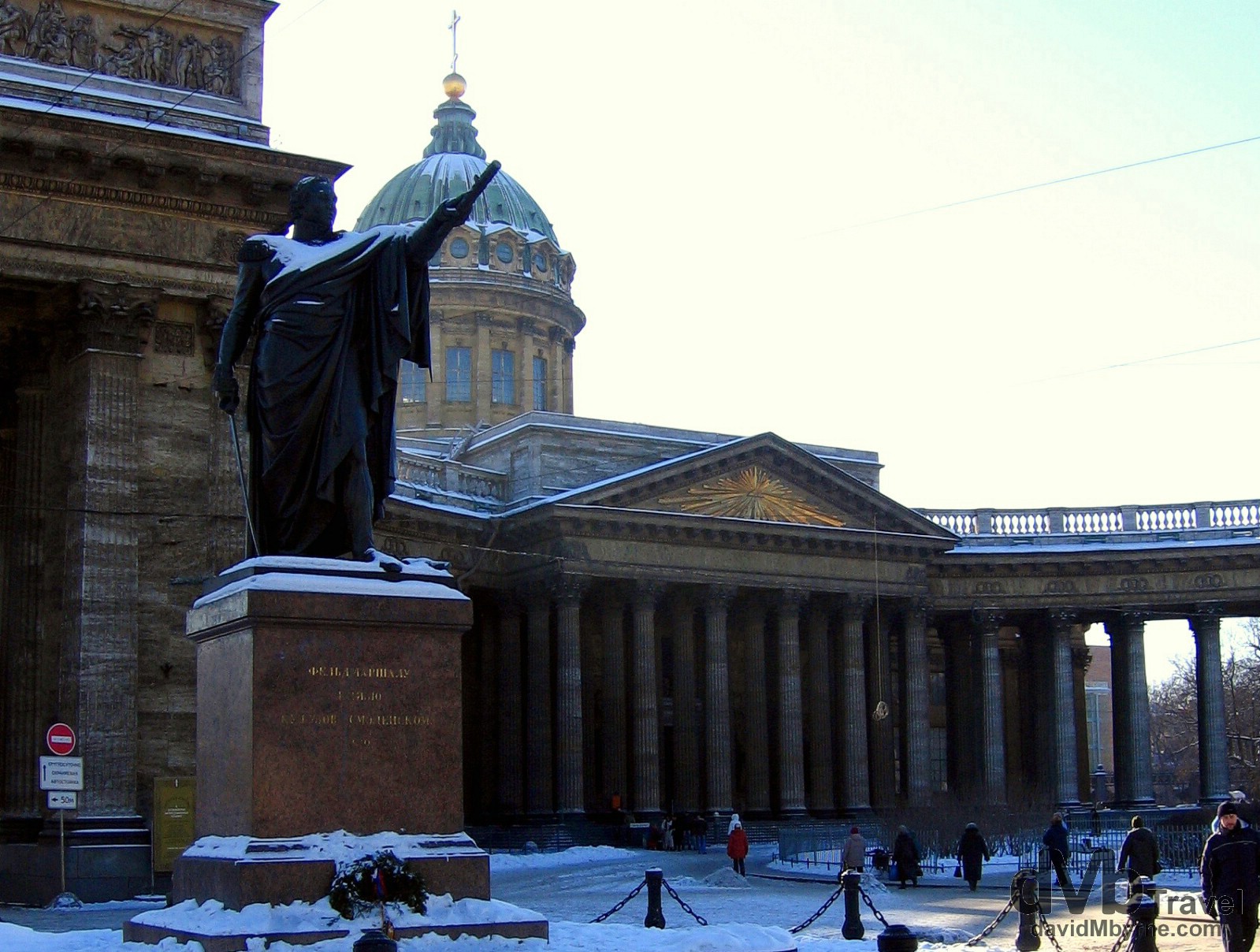
As you saunter west up Nevsky Prospekt the hugely impressive Kazan Cathedral just seems to just appear out of nowhere. Of course it doesn’t just appear out of nowhere – it just seems that way as it breaks up the scenery on bustling Nevsky Prospekt. The cathedral was built over a period of 10 years (from 1801 to 1811) and was modeled after St. Peter’s Basilica in Vatican City, even though at the time the Russian Orthodox Church strongly disapproved of the plans to create a replica of the Popish cathedral in the Russian capital. It is dedicated to Our Lady of Kazan, an icon which the Russian Orthodox Church probably venerates the most. This place is huge, way too big to capture with anything less than a wide-angle lens, and I stood here for a while trying to appreciate the sheer size of the columns holding it all up. Kazan Cathedral, Nevsky Prospekt, Saint Petersburg, Russia. February 27, 2006.
Palace Square
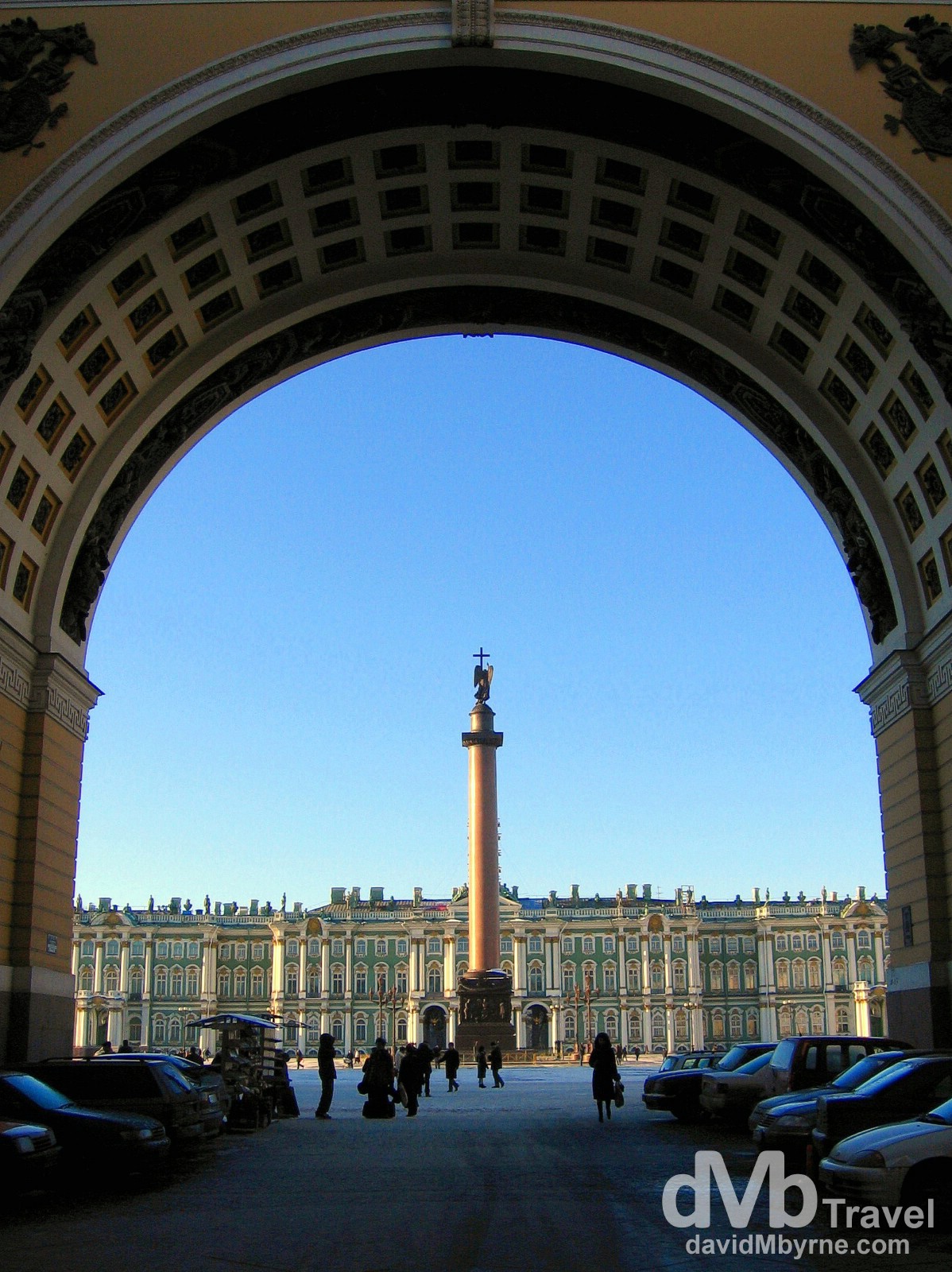
The Winter Palace & Alexander Column of Palace Square as seen from under the arches of the General Staff Building on Bol Morskaya ul. Palace Square is Saint Petersburg’s primary city square. It has been the setting of many events of worldwide significance including, most famously, the Communist October Revolution of 1917. Saint Petersburg, Russia. February 27, 2006.
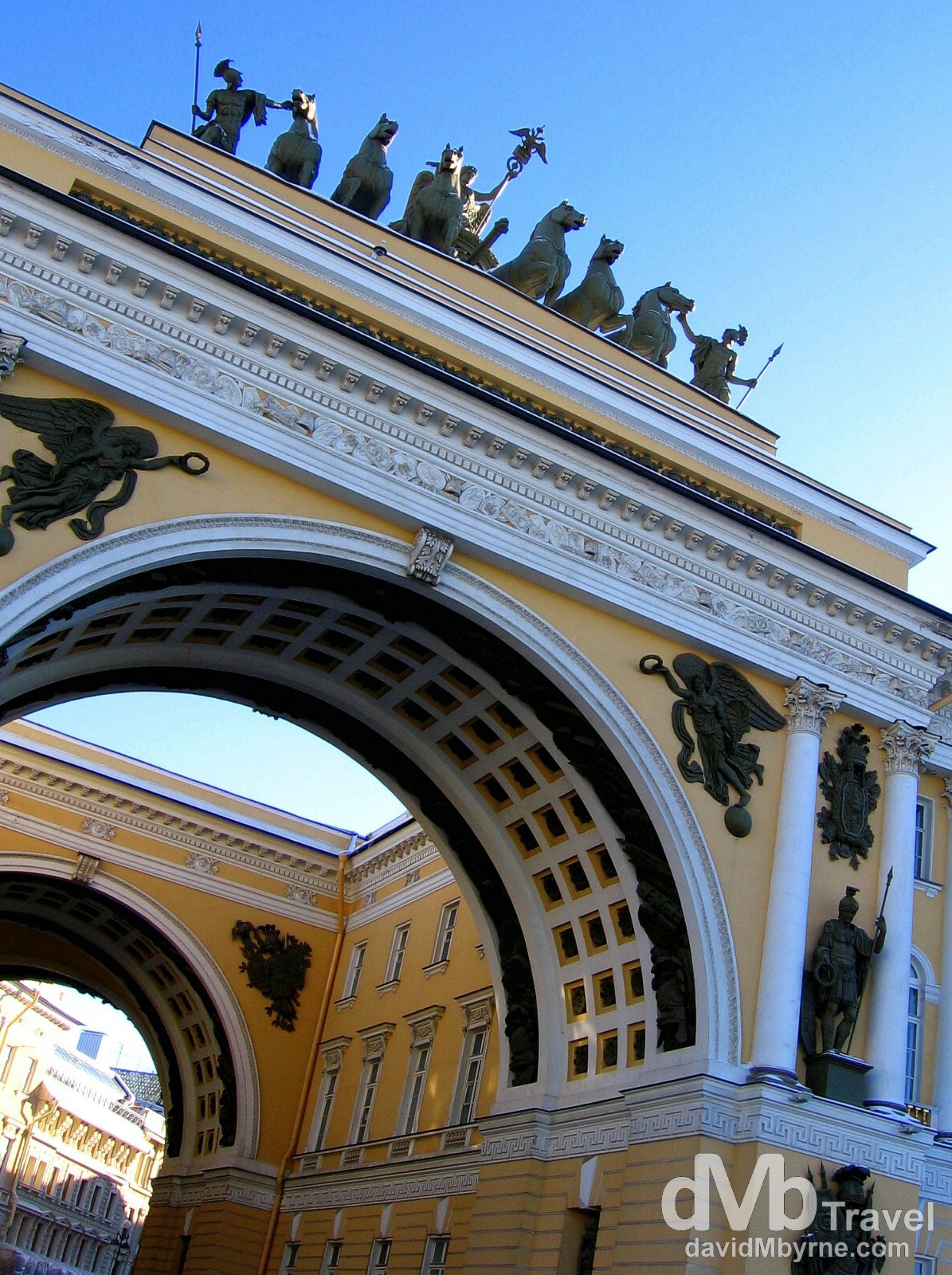
Alexander I of Russia envisaged Palace Square as a vast monument to the Russian victory over Napoleon and commissioned Carlo Rossi to design the bow-shaped Empire-style building of the General Staff Building (1819-21) at the opposite, southern, side of the square to the Winter Palace. The building centers on a double triumphal arch crowned with a Roman quadriga as seen here. Palace Square, Saint Petersburg, Russia. February 27, 2006.
– UNESCO commenting on the Historic Centre of Saint Petersburg and Related Groups of Monuments
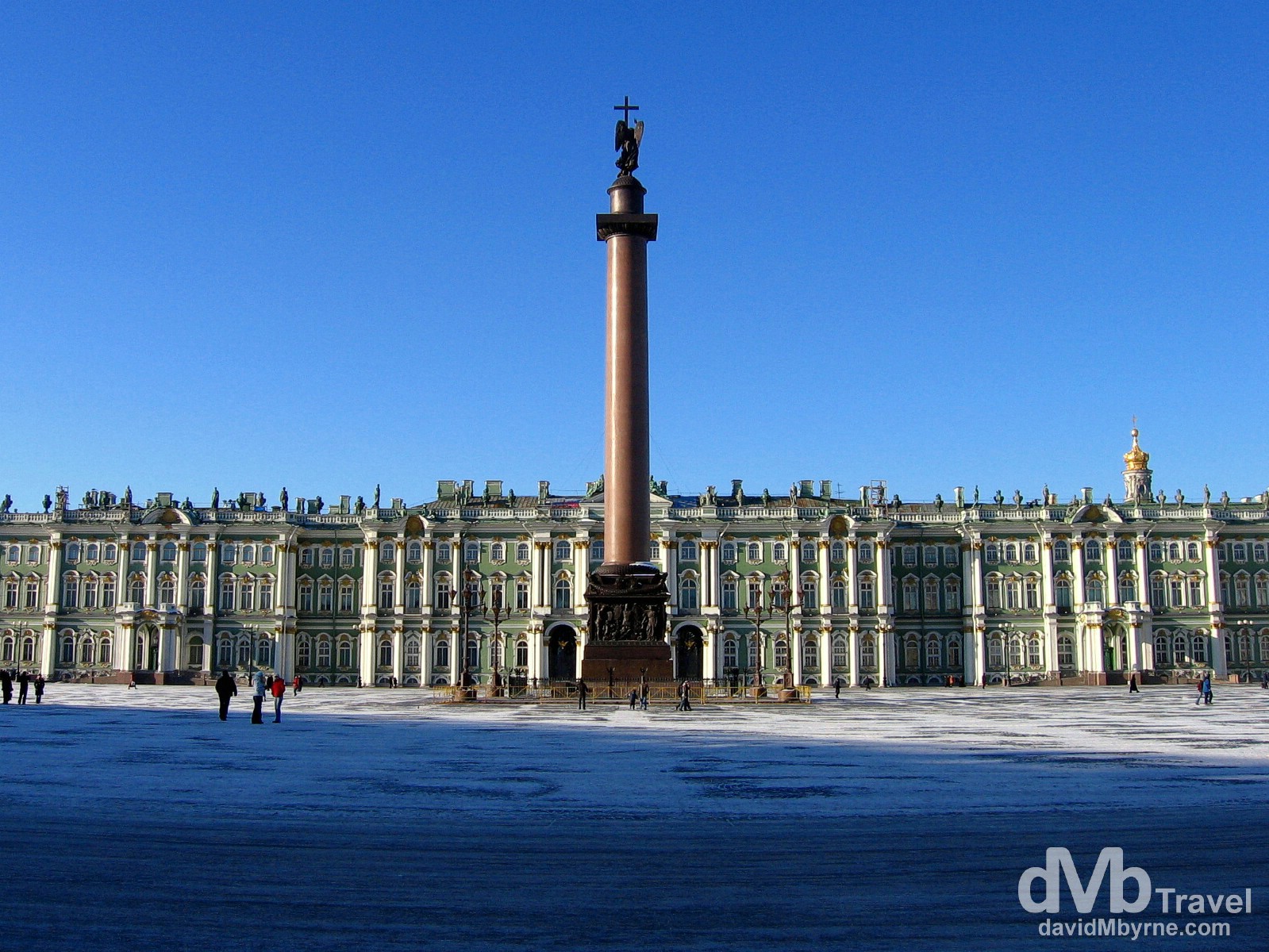
The facade of the Winter Palace & the Alexander Column in Palace Square. The earliest and most celebrated building on Palace Square is the Baroque white and green Winter Palace. Built between 1754 and 1762, it was the home of Russian tsars until 1917 – an assault of the Winter Palace by Bolshevik forces was the official milestone of the 1917 October Revolution and the beginning of the end for the 305-year-old Russian dynasty. The building is an impressive sight from afar, especially on a beautiful day, but up close it looks like it could do with the attention of a paint brush. Today the building – containing 1,945 windows and 1,786 doors in 1,057 halls and rooms – forms part of a complex of buildings known as the State Hermitage Museum, a world-famous museum holding one of the world’s greatest collections of sculptures, paintings and historic artefacts. The museum was started by Russian empress Catherine the Great in 1764 & today it owns more than 2.5 million works of art spread across almost 1,000 of those aforementioned 1,057 rooms, including world-famous masterpieces of Impressionist and Flemish art. The Alexander Column, fronting the Palace & situated in the centre of Palace Square, is a 47.5-metre high, 500 ton red granite column, the tallest of its kind in the world. It was built between 1830 and 1834 to commemorate the 1812 Russian victory over Napoleon. Palace Square, Saint Petersburg, Russia. February 27, 2006.
Admiralty
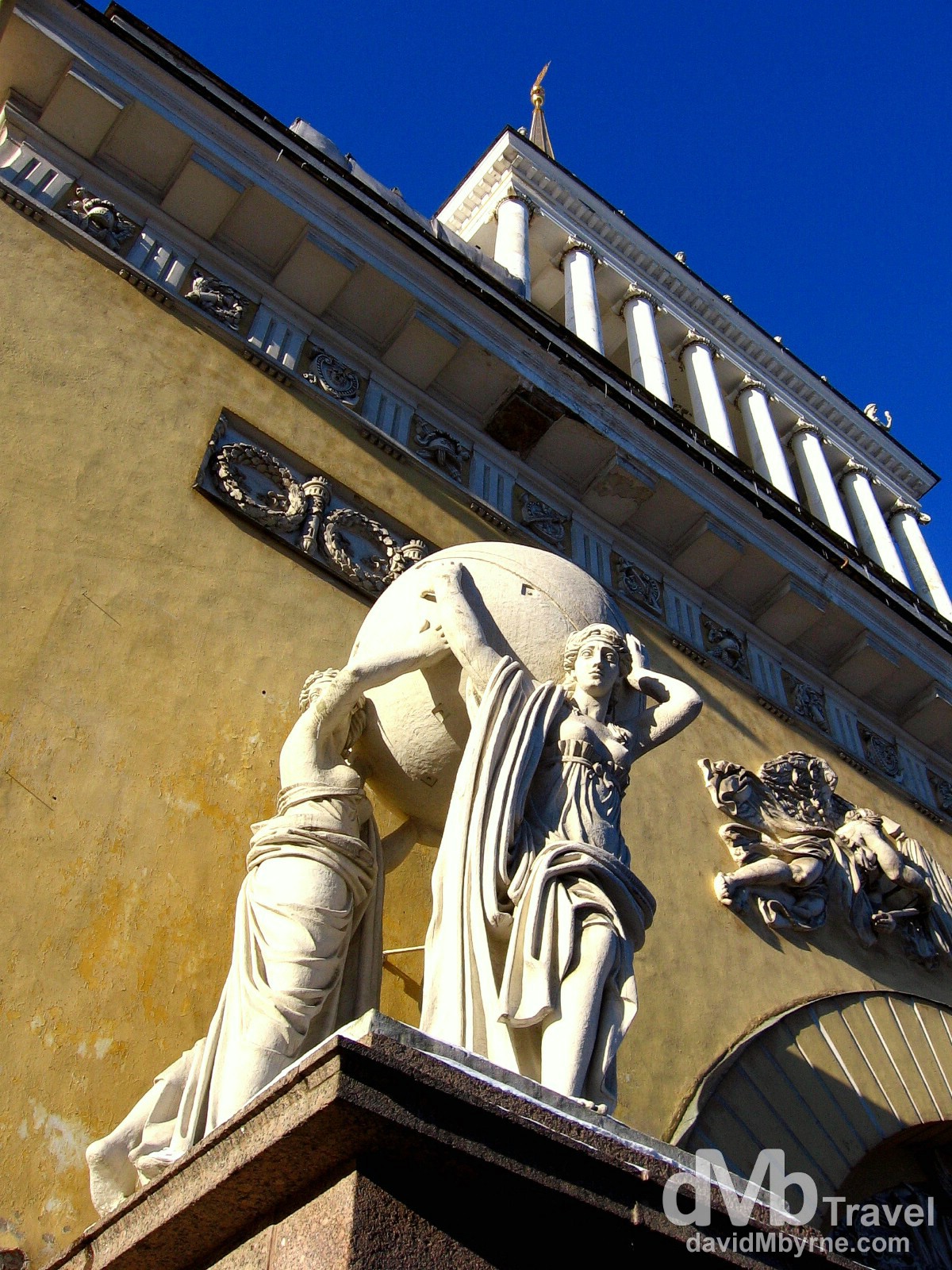
Not far from the Winter Palace is the Admiralty, home for the supreme body for the administration of the Imperial Russian Navy. The body was established by Peter the Great in 1718 and ceased to exist in 1917 as a result of the communist revolution. With a gilded steeple topped by a golden weather-vane in the shape of a small ship, it is one of the city’s most conspicuous landmarks. Just outside the walls of the Admiralty is this magnificent Empire Style edifice. Lining Admiralty Quay, it was constructed between 1806 and 1823 and, like most buildings around here, looks like it could do with a fresh lick of paint. The exterior of The Admiralty, Saint Petersburg, Russia. February 27, 2006.
Ploshchad Dekabristov (Decembrists Square)
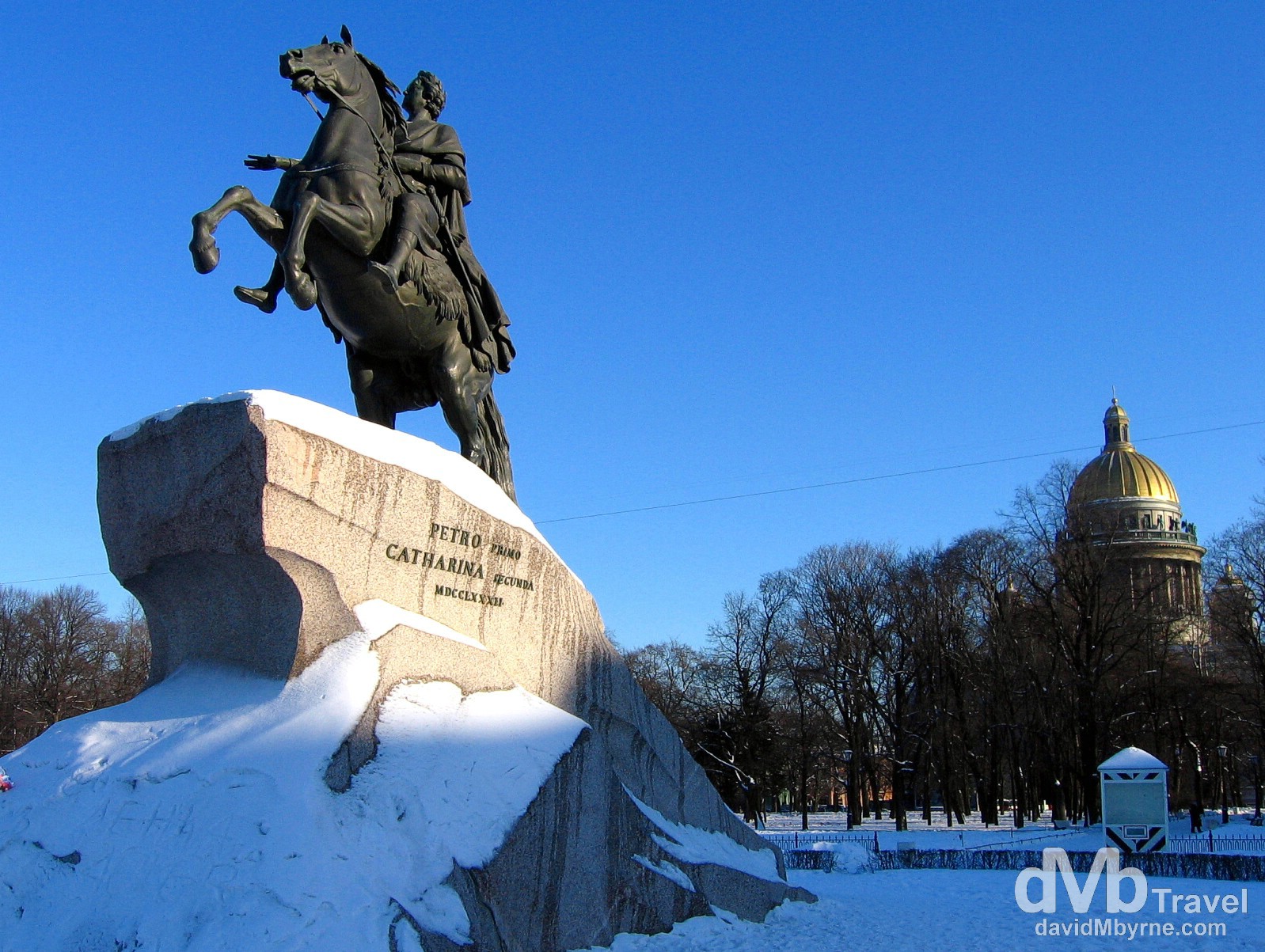
Just west of the Admiralty is Ploshchad Dekabristov (Decembrists Square) where you will find one of the most famous statues in Russia. Called the Bronze Horseman, it’s a sculpture by Etienne Maurice Falconet showing a mounted Peter the Great – The Bronze Horseman is an 1833 poem written by Aleksandr Pushkin and it is widely considered to be one of the most significant works of Russian literature. The title refers to this sculpture and the statue itself is now known as the Bronze Horseman thanks to the great influence of the poem. Pushkin himself was a Russian Romantic author who is considered to be the greatest Russian poet and the founder of modern Russian literature. He was born in Moscow in 1799 but died here in Saint Petersburg in 1837 after challenging his wife’s alleged lover to a duel in which he suffered mortal injuries. In the background, across Admiralty Gardens, can be seen the splendid golden dome of the city’s massively impressive Saint Isaac’s Cathedral. Ploshchad Dekabristov (Decembrists Square) in St Petersburg, Russia. February 27, 2006.
The Church of the Savior on Spilled Blood
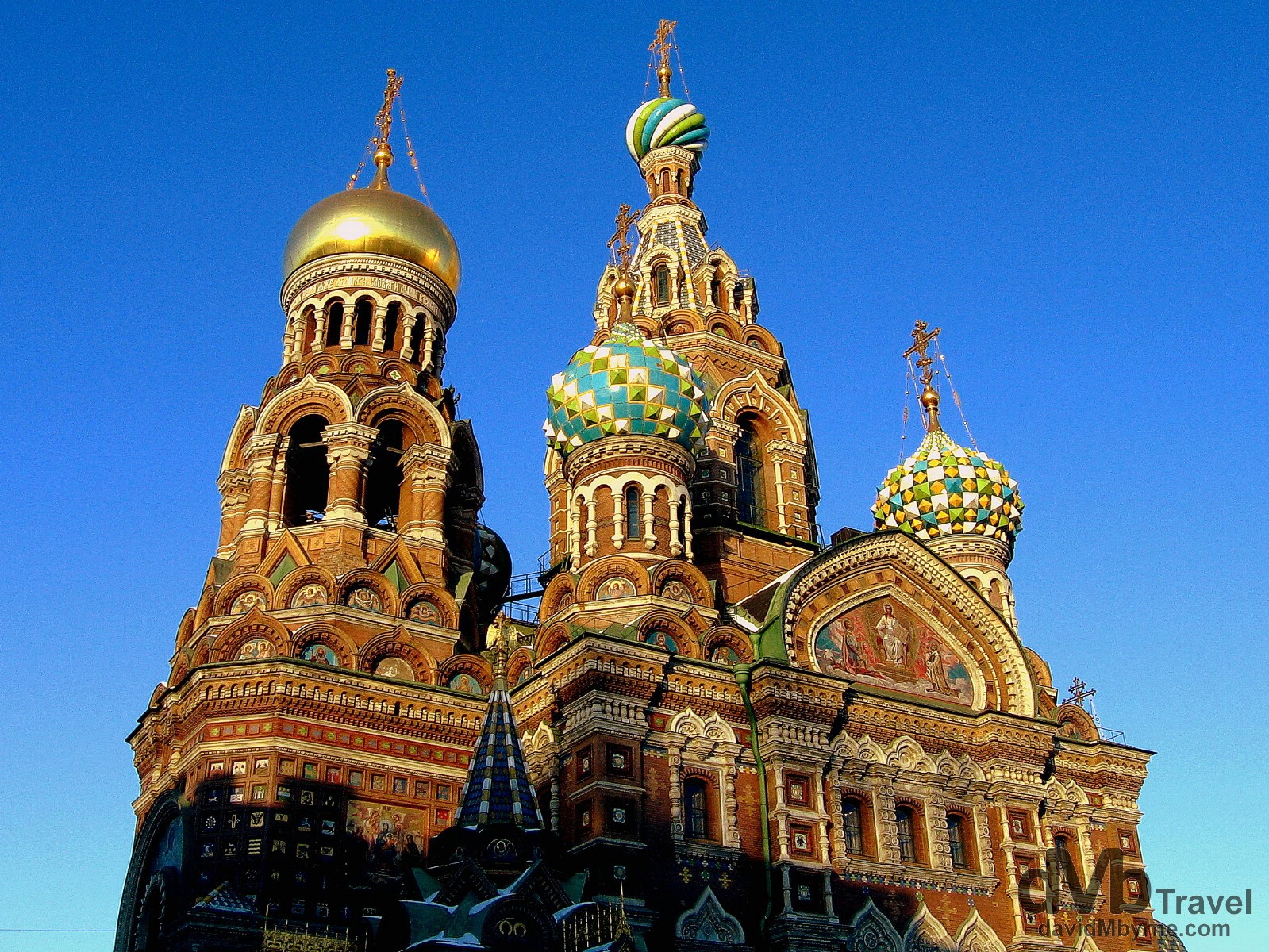
The Church of the Savior on Spilled Blood (also called the Church on Spilt Blood and the Cathedral of the Resurrection of Christ, the latter being its official name) is one of the main Russian Orthodox churches in Saint Petersburg. The name refers to the blood of the assassinated Alexander II of Russia who was mortally wounded on the site of the church in March 1881. Construction began in 1883 under Alexander III as a memorial to his father. Funding issues meant work progressed slowly and the church wasn’t completed until 1907. In the spirit of romantic nationalism, the building’s medieval Russian architecture harks back to the styles of the past and differs from the Baroque and Neoclassical styles of the city’s other notable structures. It intentionally resembles the celebrated St. Basil’s Cathedral in Moscow and to the untrained eye, including mine, the similarities are obvious. The Church contains over 7,500 square metres of mosaics which, according to its restorers, is more than any other church in the world. Like all buildings in the city the church suffered during the communist days – it was used as a vegetable warehouse, among other uses, during World War II. A restoration project was begun in 1970 and the church was reopened a mere 27 years later in August 1997. It hasn’t been re-sanctified and does not function as a full-time place of worship, a function it never fulfilled, even prior to the Revolution – it was dedicated exclusively to the memory of the assassinated tsar & it only ever commemorated funeral liturgies. The Church is now one of the main tourist attractions in the city with a somewhat hefty fee charged to ogle at its innards. Church of the Savior on Spilled Blood, Saint Petersburg, Russia. February 27, 2006.
Mars Field
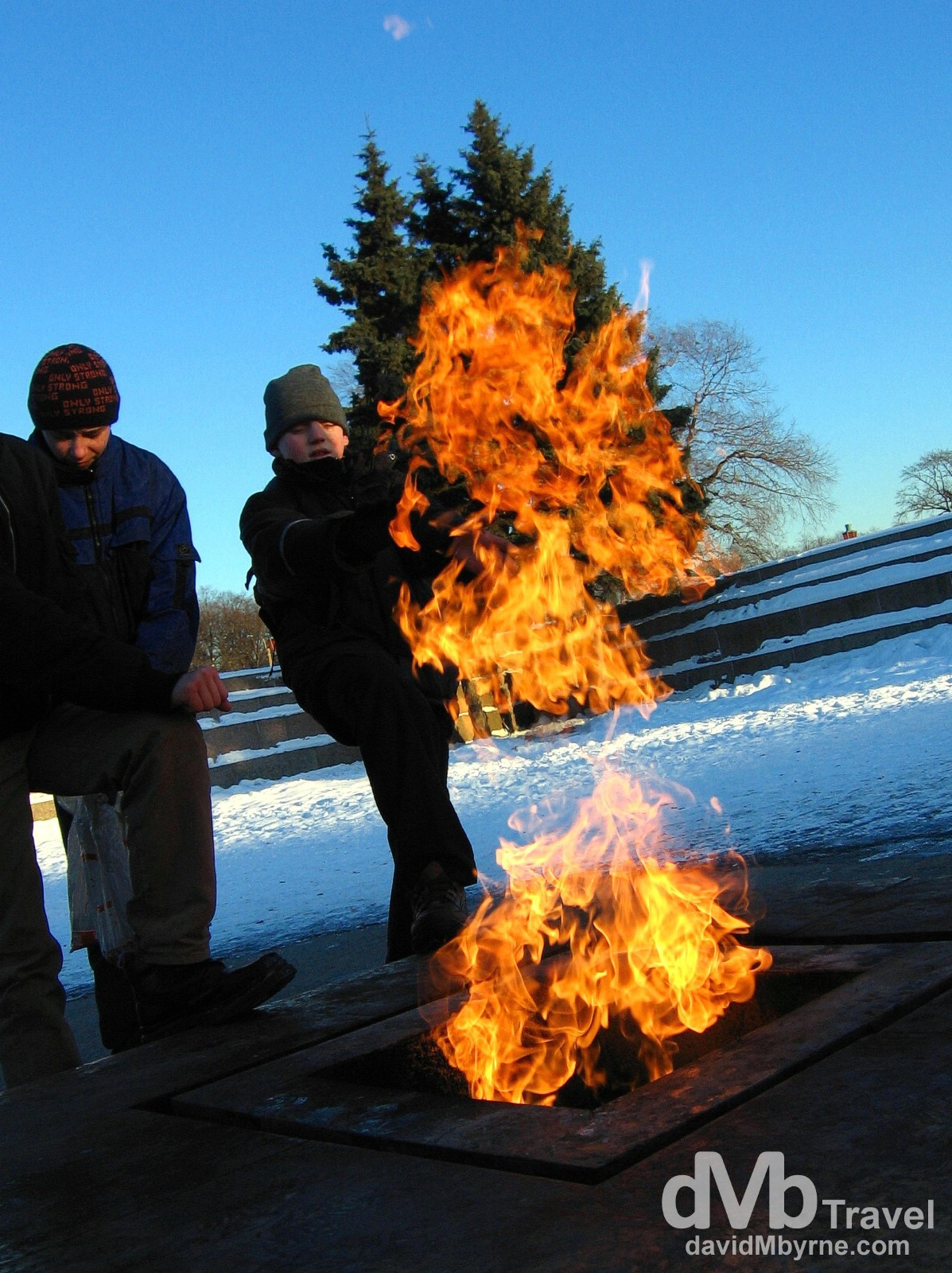
Trying to keep warm in Mars Field, an expansive park & square named after the Roman God of war. Located on the south side of the city’s Neva River, it was here, during the 1917 revolution, that many people were killed leading the Bolsheviks to construct the existing memorial and this eternal flame. They also renamed the field to “Victims of the Revolution Square”. It seems to attract a mixture of students, alcoholics and the homeless. And me. Mars Field, Saint Petersburg, Russia. February 27, 2006.
Saint Peter & Paul Fortress
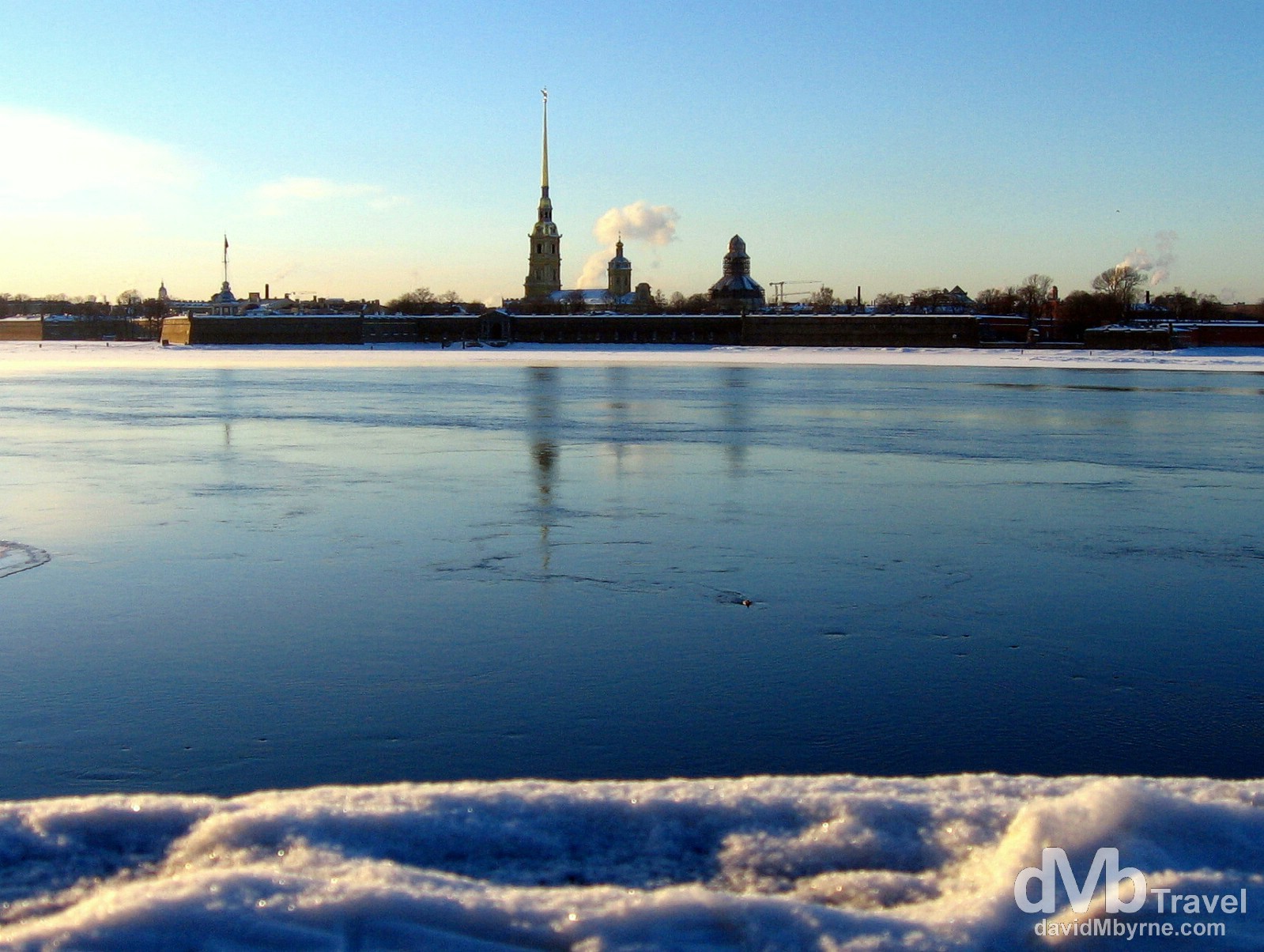
A late afternoon picture taken from the Troitsky most (bridge) looking across Saint Petersburg’s Neva River to the Petrograd area of the city and its principle attraction, the Peter & Paul Fortress on Zayachy Island. The fortress was built in 1703 under Peter the Great’s command. It was the original military fortress for the new city, built for protection against a potential attack by the Swedish navy during the Great Northern War. However, that attach never materialised and the fortress was never actually needed for warring purposes; it was mainly used as a prison. During the Communist Revolution of 1917-1918, the fortress served as a place of refuge for many of the cities Tsarist officials – when their position eventually became hopeless they surrendered to the communists without a struggle. The fortress contains a number of buildings, the best known of which is the impressive Peter and Paul Cathedral, one of the better know city landmarks thanks to its 404-feet tall, angel-topped spire. It was the first cathedral built out of stone in the city and it houses the remains of almost all the Russian Emperors and Empresses from Peter the Great to Nicholas II, the last Russian Tsar who was famously murdered in Yekaterinburg in 1918 by the communists – Nicholas II and his family were finally laid to rest here, as part of a full state funeral, in July 1998. Another late arrival was Maria Feodorovna, Empress of Russia, Wife of Tsar Alexander III and mother of Nicholas II. She died in exile on October 13, 1928, in her native Denmark. In 2005, the governments of Denmark and Russia agreed that the Empress’s remains should be returned to Saint Petersburg in accordance with her wish to be interred next to her husband. Therefore, and on September 28, 2006, 78 years after her death, she was reinterred in the cathedral. Saint Petersburg, Russia. February 27, 2006.
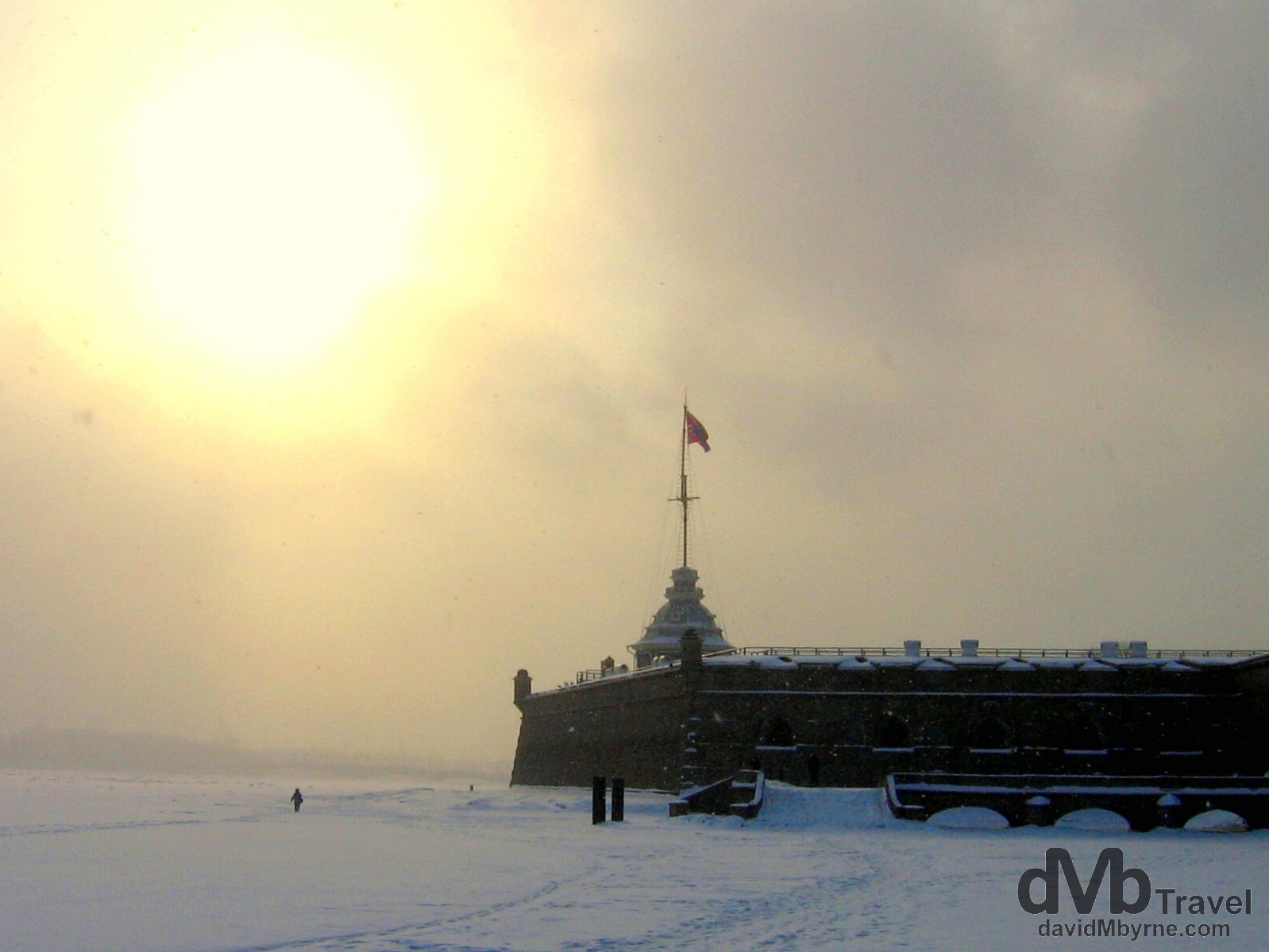
A snow blizzard outside the walls of the Peter & Paul Fortress in St. Petersburg, Russia. February 28, 2006.
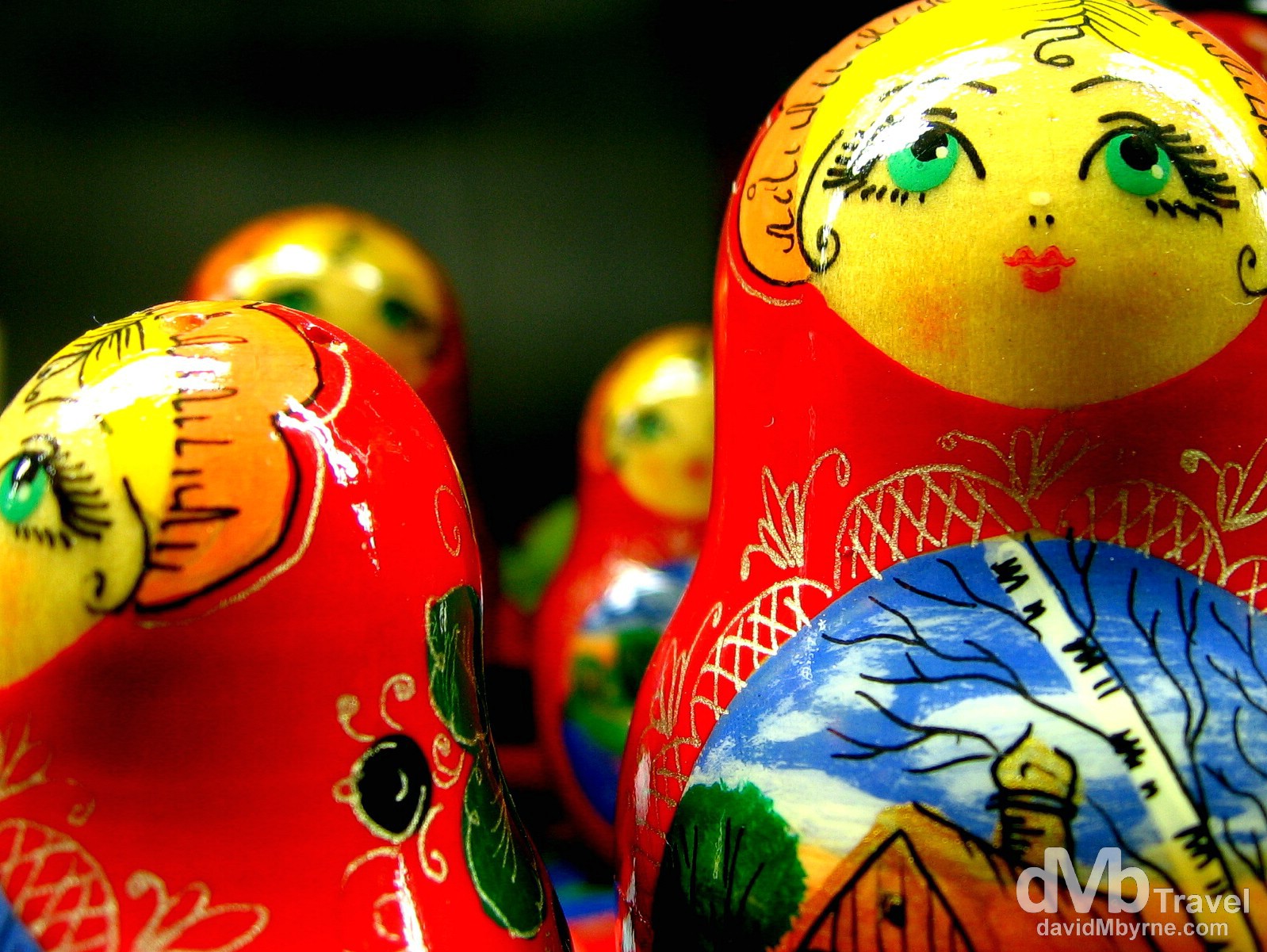
In the grounds of the Peter & Paul Fortress I discovered a nice little souvenir shop that provided me with some much needed shelter from the cold. The shop houses a replica of the first sailing boat used by Peter the Great, the founder of the city. It was in here that I took this picture of a set of oh-so Russian Matryoshka dolls, a set of dolls of decreasing sizes placed one inside another. The number of nested figures is usually six or more. The shape is mostly cylindrical, rounded at the top for the head and tapered towards the bottom, but little else; the dolls have no hands (except those that are painted). The artistry is in the painting of each doll, which can be extremely elaborate. Matryoshkas are a relatively new Russian handicraft; the first one dates from 1890 and is said to have been inspired by souvenir dolls from Japan. However, the concept of nested objects was familiar in Russia having been applied to carved wooden apples and Easter eggs – the first Faberge egg, dating to 1885, had a nesting of egg, yolk, hen, and crown. Speaking of Faberge Eggs. The souvenir shop also has a range of those wholly Russian handicraft on display, none of which were even remotely cheap. It all started in 1885 when the then Tsar Alexander III commissioned Carl Faberge to fashion for his wife, Empress Maria, a gift for Easter, an important Holy Day for the Russian Orthodox Church and one normally celebrated with an exchange of eggs and three kisses. The gift went down so well with the Empress that the tsar commissioned one egg every Easter thereafter. The tradition was continued by Alexander’s son, Nicholas II, except that he had two crafted – one for his wife and one for his mother. Each one was a unique creation of enameled gold & jewels that took a small army a year to design and create & contained a small surprise – a tiny coronation coach, a replica of the royal yacht, a train, windup animals, or some interactive mechanical miniature etc. Of the 56 priceless works that were made, 47 are known to exist today. The whereabouts of the other 9 is still a mystery. In the souvenir shop of the Peter & Paul Fortress, Saint Petersburg, Russia. February 28, 2006.
Finland Station
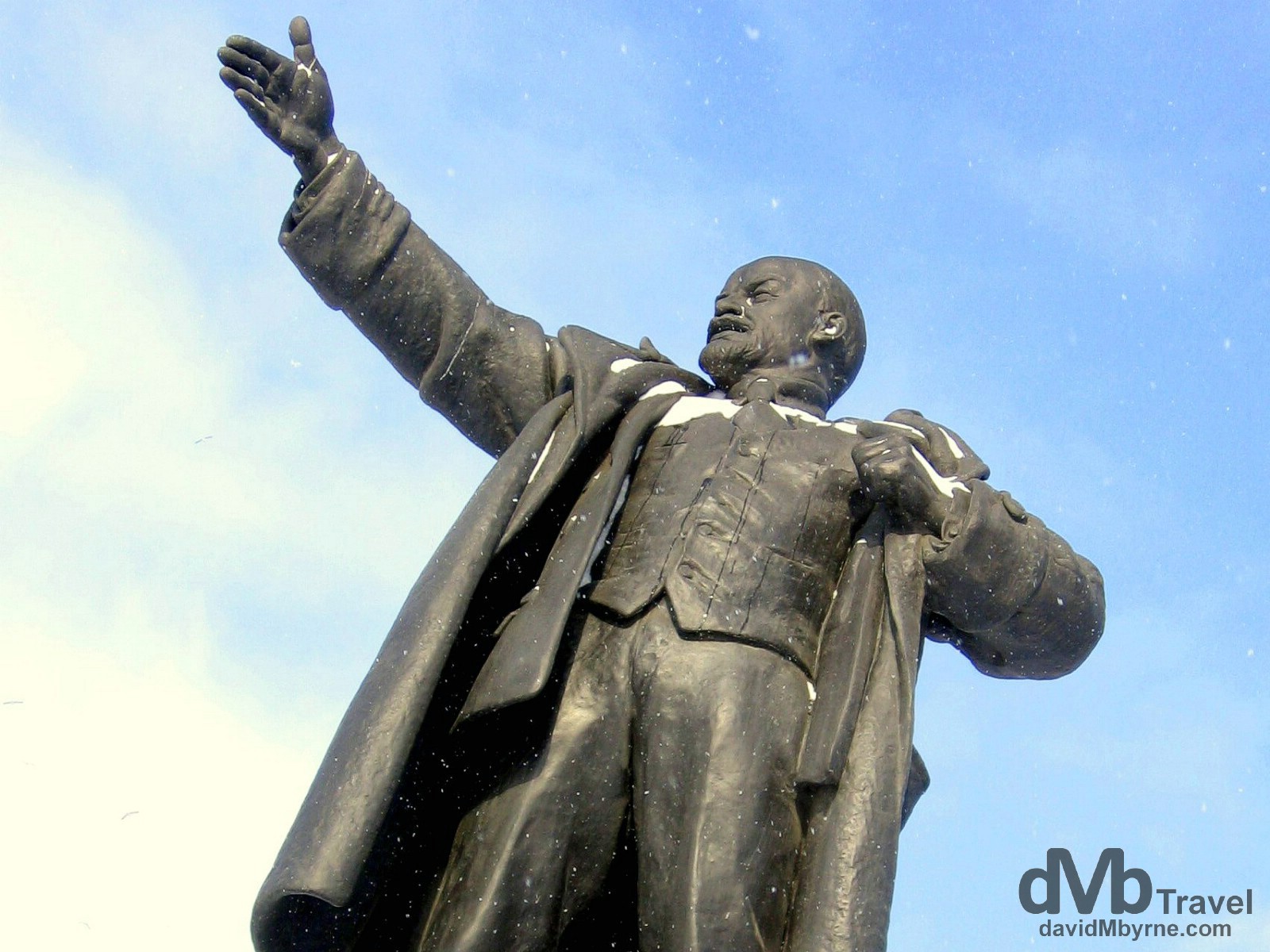
Saint Petersburg’s Finland Train Station has an interesting history. Opened in 1870, it was built, owned & operated by Finnish State Railways until early 1918 when the last train carrying station personnel and equipment, plus some of the last Finns escaping revolutionary Russia, left for Finland. The station is best remembered however for the arrival, on April 3, 1917, of Vladimir Lenin. He came out of exile in Finland to start the October Revolution in the city. Lenin traveled from Finland disguised as a railway worker on engine #293. Decades later the steam locomotive was donated by Finland to the Soviet Union and is now installed as a permanent exhibit at the station. The event is also commemorated by this Soviet statue of Lenin dominating the square, Pl Lenina, in front of the station. Saint Petersburg, Russia. February 28, 2006.
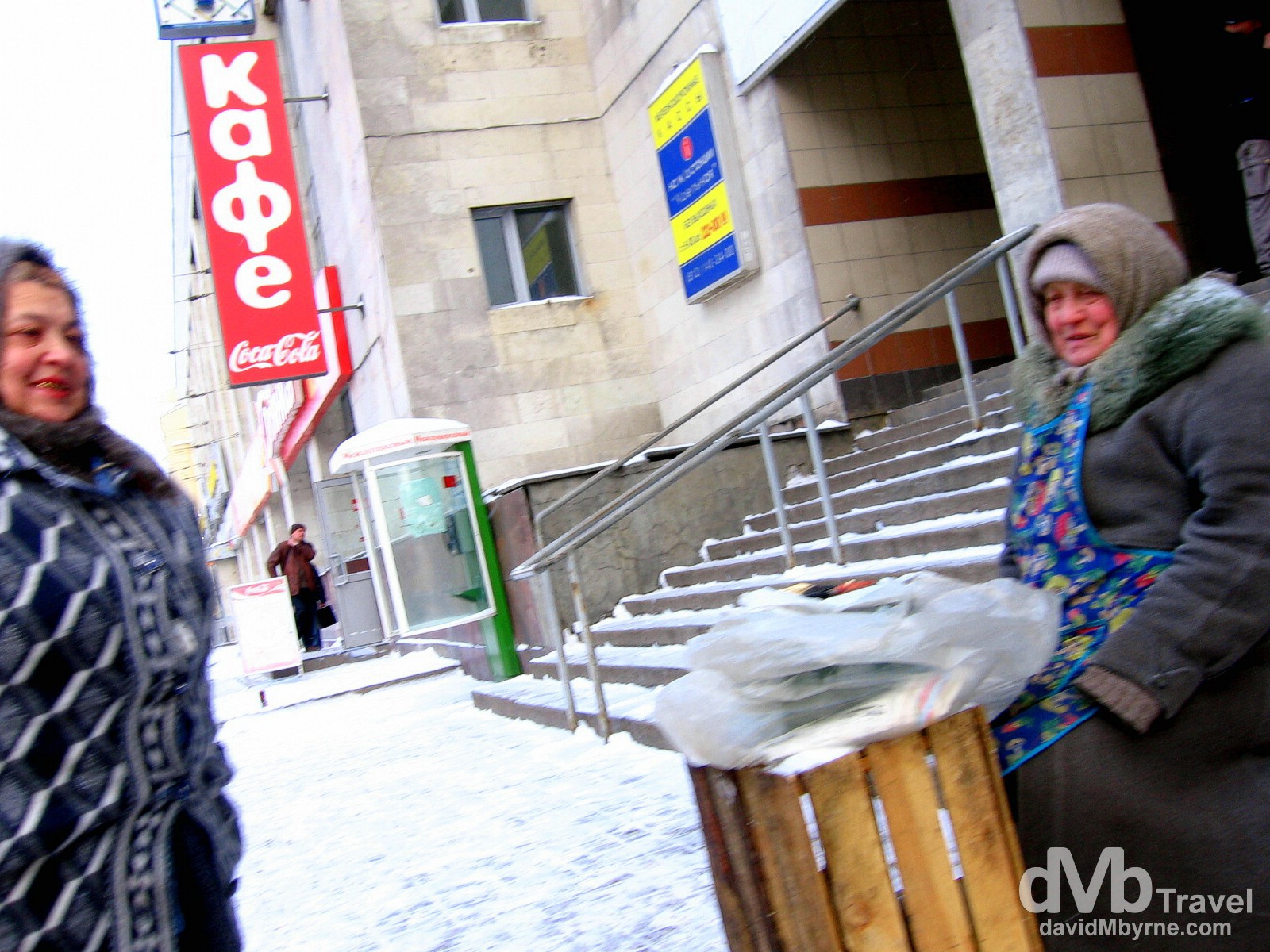
Trying to keep warm outside Finland Station in St. Petersburg, Russia. February 28, 2006.
______________________________________________________________________
